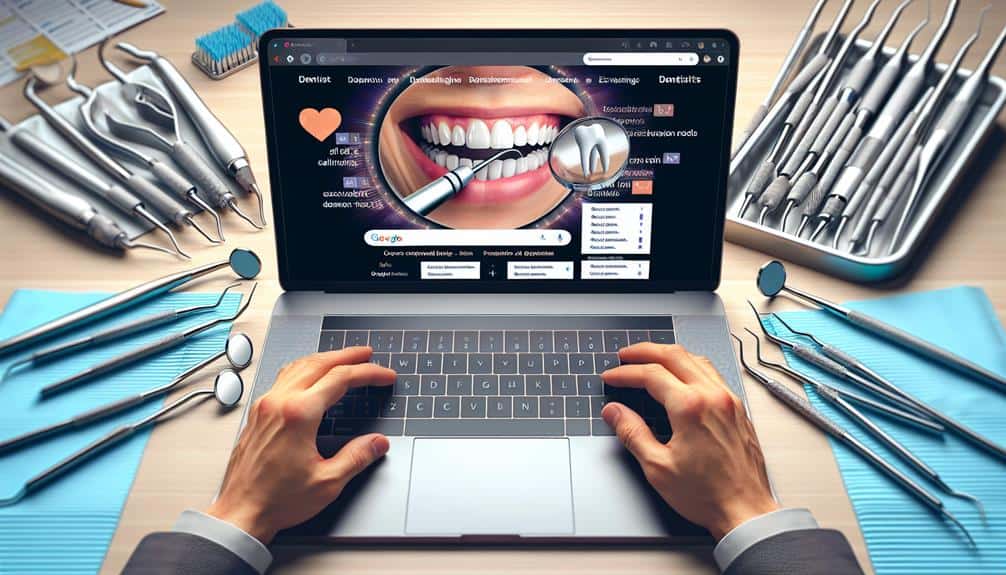Are you a dentist looking to improve your website’s search engine optimization (SEO)?
While you may already be aware of the importance of keywords and content, have you considered the role that images play in optimizing your website?
Images can not only enhance the overall user experience but can also contribute to better SEO when optimized correctly.
But how can dentists optimize images to maximize their impact on search rankings?
In this discussion, we will explore some key strategies that can help you optimize your dental images for better SEO, attracting more potential patients to your website.
Key Takeaways
- Choose the appropriate image format (JPEG, PNG, SVG) based on the content and requirements to balance image quality and file size.
- Use descriptive file names with relevant keywords and hyphens for better readability by search engines.
- Utilize alt tags to provide textual descriptions of images, improving accessibility for visually impaired users and helping search engines understand image content.
- Compress images to reduce file size and improve website loading speed, enhancing user experience and SEO rankings.
Choose the Right Image Format
To optimize your images for better SEO, it’s important to choose the right image format. The image format you choose can have a significant impact on the overall performance of your website. One of the key factors to consider when choosing an image format is its ability to optimize image quality without sacrificing loading speed.
JPEG (Joint Photographic Experts Group) is one of the most commonly used image formats for websites. It offers a good balance between image quality and file size. JPEG is ideal for photographs or images with complex color gradients. However, it isn’t suitable for images with transparency or sharp lines and text.
On the other hand, PNG (Portable Network Graphics) is a lossless image format that supports transparency. It’s best suited for images with sharp lines, text, or logos. PNG images tend to have larger file sizes compared to JPEG, but they maintain their high quality.
For simple graphics or icons, you can consider using SVG (Scalable Vector Graphics). SVG files are small in size and can be scaled without losing quality. They’re great for responsive design and can help improve loading speed.
Optimize File Names for Better SEO
Optimizing your file names is a crucial step in improving SEO for your images. By following these guidelines, you can improve image visibility and enhance website aesthetics:
- Use descriptive names: Instead of generic file names like ‘IMG_1234.jpg,’ use descriptive names that accurately describe the image content. For example, ‘dentist-patient-smiling.jpg’ is more informative and keyword-rich.
- Keep it concise: Use short and meaningful file names that accurately represent the image. Long and convoluted file names can be confusing and may not be fully displayed in search results.
- Utilize keywords: Incorporate relevant keywords in your file names to improve the chances of your images being discovered by search engines. For instance, if you have an image of teeth whitening, include keywords like ‘teeth-whitening-before-after.jpg’ in the file name.
- Separate words with hyphens: Use hyphens to separate words in your file names. This makes it easier for search engines to read and understand the content of the image.
- Avoid special characters: Stick to alphanumeric characters and hyphens in your file names. Special characters can cause issues with indexing and may not be recognized by search engines.
Utilize Descriptive Alt Tags
When optimizing your images for better SEO, make sure to utilize descriptive alt tags. Alt tags, also known as alternative text or alt attributes, provide a textual description of an image. These tags are important for image optimization as they help search engines understand the content of the image and improve the overall visibility of your website.
The importance of image optimization can’t be overstated. By optimizing your images, you can enhance the user experience, increase website load speed, and boost your search engine rankings. Alt tags play a crucial role in this optimization process. When creating alt tags, it’s best to use descriptive keywords that accurately describe the image. This won’t only improve the accessibility of your website for visually impaired users but also provide search engines with relevant information about the image.
To optimize alt tags, follow these best practices:
- Be descriptive: Use concise and accurate descriptions that reflect the content and purpose of the image.
- Include relevant keywords: Incorporate relevant keywords that align with your overall SEO strategy.
- Avoid keyword stuffing: While keywords are important, it’s essential to strike a balance and avoid overusing them.
Compress Images for Faster Loading Times
For faster loading times, compressing your images is essential. Optimizing your images by reducing their file size can significantly improve the loading speed of your dental website, providing a better user experience and boosting your SEO efforts.
Here are some key reasons why compressing images is crucial:
- Reduce image dimensions: By resizing your images to match the required dimensions on your website, you can minimize the file size without sacrificing quality. This helps to decrease the load time of your web pages.
- Improve page load speed: Compressed images load faster, ensuring that your website visitors don’t have to wait long for your content to appear. This can result in lower bounce rates and increased user engagement.
- Enhance mobile performance: Mobile users often have limited bandwidth and slower internet connections. Compressed images optimize the mobile experience by reducing data usage and loading times.
- Boost SEO rankings: Page speed is an important ranking factor for search engines. By compressing your images, you can improve your website’s loading speed, which can positively impact your SEO rankings.
- Use lazy loading: Implementing lazy loading allows your website to load images only when they’re visible to the user. This technique further improves loading times by prioritizing the content above the fold.
Use Responsive Design for Mobile Optimization
To optimize your website for mobile devices, implement responsive design. Mobile friendly websites are essential for providing a seamless user experience and improving your website’s SEO. With the increasing number of people accessing the internet through their smartphones and tablets, it is crucial to ensure that your website is easily accessible and navigable on mobile devices.
Responsive design allows your website to adapt to different screen sizes and resolutions, ensuring that your content is displayed properly on any device. This means that your website will look great and function effectively on smartphones, tablets, and desktop computers alike.
By using responsive design, you can also optimize your images for mobile devices. Implementing image optimization techniques specific to mobile devices can further enhance the user experience. Consider the following table that illustrates some image optimization techniques for mobile optimization:
| Image Optimization Techniques for Mobile Optimization |
| Use smaller image files |
| Implement lazy loading |
| Use the correct image format |
| Optimize alt text and captions |
Frequently Asked Questions
How Do Image Formats Affect SEO for Dentists?
Using the right image file formats and applying image optimization techniques can greatly impact your SEO. By choosing formats that are web-friendly and optimizing images for speed and relevance, you can improve your website’s visibility and ranking.
Are There Any Specific Guidelines for Optimizing File Names for Dental Images?
When it comes to optimizing file names for dental images, it’s important to be descriptive and include relevant keywords. Additionally, using descriptive alt tags can help improve your SEO strategy.
What Are Some Examples of Descriptive Alt Tags That Dentists Can Use for Their Images?
To optimize your dental images for better SEO, use descriptive alt tags that accurately describe the content of the image. Examples include “smiling patient after teeth whitening” or “dentist examining a patient’s teeth.”
How Does Compressing Images Improve Loading Times and SEO for Dental Websites?
Compressing images improves loading times and SEO for dental websites. It reduces file size without sacrificing quality, making your site faster and more accessible. Optimize file names to include relevant keywords for better search engine visibility.
Can You Provide Tips on How Dentists Can Ensure Their Website Is Optimized for Mobile Devices?
To ensure your website is optimized for mobile devices, follow these tips: prioritize responsive design, compress images, minimize HTTP requests, use caching, and optimize CSS and JavaScript. Speed and mobile-friendliness are crucial for better user experience and SEO.
Conclusion
Congratulations! You’ve now mastered the art of optimizing images for better SEO. By choosing the right format, optimizing file names, utilizing descriptive alt tags, compressing images, and implementing responsive design, you’re on your way to dominating the search results.
Dentists everywhere will be in awe of your SEO skills, and your website will soar to new heights. So go ahead, put your newfound knowledge to use and watch your online visibility skyrocket.
Happy optimizing!

Suraj Rana is a renowned Dental SEO Expert, deeply committed to elevating dental practices in the online landscape. With a profound understanding of technical SEO, he specializes in tailoring on-page optimization strategies specifically for the dental industry. Suraj’s extensive experience spans across various sectors, but his passion truly lies in transforming the digital presence of dental clinics. His expertise in dental-specific search engine optimization, combined with a data-driven approach, empowers him to develop strategies that significantly increase organic traffic, enhance search engine rankings for dental-related keywords, and ultimately drive business growth for his dental clients. Suraj Rana’s unique blend of SEO skills and dedication to the dental field make him an invaluable asset to any dental practice looking to thrive online.


